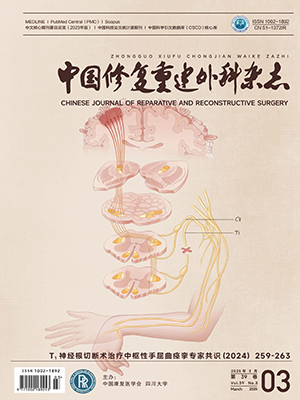| 1. |
Updegrove GF, Mourad W, Abboud JA. Humeral shaft fractures. J Shoulder Elbow Surg, 2018, 27(4): e87-e97.
|
| 2. |
Gallusser N, Barimani B, Vauclair F. Humeral shaft fractures. EFORT Open Rev, 2021, 6(1): 24-34.
|
| 3. |
Entezari V, Olson JJ, Vallier HA. Predictors of traumatic nerve injury and nerve recovery following humeral shaft fracture. J Shoulder Elbow Surg, 2021, 30(12): 2711-2719.
|
| 4. |
Streufert BD, Eaford I, Sellers TR, et al. Iatrogenic nerve palsy occurs with anterior and posterior approaches for humeral shaft fixation. J Orthop Trauma, 2020, 34(3): 163-168.
|
| 5. |
Chirattikalwong S, Suwannaphisit S, Wuttimanop W, et al. Risk of radial nerve injury in anterolateral humeral shaft plating. J Am Acad Orthop Surg, 2022, 30(18): 903-909.
|
| 6. |
Oliver WM, Searle HKC, Ng ZH, et al. Factors associated with humeral shaft nonunion. J Shoulder Elbow Surg, 2021, 30(10): 2283-2295.
|
| 7. |
Robinson CM, Stirling PHC, MacDonald DJ, et al. Open reduction and long locking plate fixation of complex proximal humeral metadiaphyseal fractures. J Bone Joint Surg (Am), 2020, 102(24): 2146-2156.
|
| 8. |
Randell M, Glatt V, Stabler A, et al. Anterior minimally invasive plate osteosynthesis for humeral shaft fractures is safer than open reduction internal fixation: A matched case-controlled comparison. J Orthop Trauma, 2021, 35(8): 424-429.
|
| 9. |
Giordano M, Giordano V, Gameiro VS, et al. Anterior minimally invasive plating osteosynthesis technique (MIPO) for humeral shaft fractures: an anatomical study of neuromuscular structures at risk. Eur J Orthop Surg Traumatol, 2021, 31(3): 449-458.
|
| 10. |
Beeres FJ, Diwersi N, Houwert MR, et al. ORIF versus MIPO for humeral shaft fractures: a meta-analysis and systematic review of randomized clinical trials and observational studies. Injury, 2021, 52(4): 653-663.
|
| 11. |
Tetsworth K, Hohmann E, Glatt V. Minimally invasive plate osteosynthesis of humeral shaft fractures: Current state of the art. J Am Acad Orthop Surg, 2018, 26(18): 652-661.
|
| 12. |
王贤, 尹东, 梁斌, 等. 螺旋钢板微创内固定治疗肱骨干近段骨折的临床疗效. 中国修复重建外科杂志, 2016, 30(7): 799-803.
|
| 13. |
García-Virto V, Santiago-Maniega S, Llorente-Peris A, et al. MIPO helical pre-contoured plates in diaphyseal humeral fractures with proximal extension. Surgical technique and results. Injury, 2021, 52 Suppl 4: S125-S130.
|
| 14. |
Acosta-Olivo C, Garza-Borjon A, Simental-Mendia M, et al. Delayed union of humeral shaft fractures: comparison of autograft with and without platelet-rich plasma treatment: a randomized, single blinded clinical trial. Arch Orthop Trauma Surg, 2017, 137(9): 1247-1252.
|
| 15. |
Stedtfeld HW, Biber R. Proximal third humeral shaft fractures—a fracture entity not fully characterized by conventional AO classification. Injury, 2014, 45 Suppl 1: S54-S59.
|
| 16. |
Lau TW, Leung F, Chan CF, et al. Minimally invasive plate osteosynthesis in the treatment of proximal humeral fracture. Int Orthop, 2007, 31(5): 657-664.
|
| 17. |
Ji F, Tong D, Tang H, et al. Minimally invasive percutaneous plate osteosynthesis (MIPPO) technique applied in the treatment of humeral shaft distal fractures through a lateral approach. Int Orthop, 2009, 33(2): 543-547.
|
| 18. |
Chamseddine AH, El-Hajj OM, Haidar IM, et al. Minimally invasive percutaneous plate osteosynthesis for treatment of proximal humeral shaft fractures. Int Orthop, 2021, 45(1): 253-263.
|
| 19. |
Rancan M, Dietrich M, Lamdark T, et al. Minimal invasive long PHILOS®-plate osteosynthesis in metadiaphyseal fractures of the proximal humerus. Injury, 2010, 41(12): 1277-1283.
|
| 20. |
Jeong JJ, Park SE, Lee HH, et al. Narrow locking compression plate vs long philos plate for minimally invasive plate osteosynthesis of spiral humerus shaft fractures. BMC Musculoskelet Disord, 2019, 20(1): 381. doi: 10.1186/s12891-019-2757-z.
|
| 21. |
Benninger E, Meier C. Minimally invasive lateral plate placement for metadiaphyseal fractures of the humerus and its implications for the distal deltoid insertion-it is not only about the radial nerve. A cadaveric study. Injury, 2017, 48(3): 615-620.
|
| 22. |
Arumilli B, Suhm N, Marcel J, et al. Long PHILOS plate fixation in a series of humeral fractures. Eur J Orthop Surg Traumatol, 2014, 24(8): 1383-1387.
|
| 23. |
Zamboni C, Carmo BL, Moraes LVM, et al. A practical guide for the use of contour locking plates for the repair of humeral diaphyseal fractures with proximal extension. Injury, 2019, 50(12): 2247-2251.
|
| 24. |
Pastor T, Kastner P, Souleiman F, et al. Anatomical analysis of different helical plate designs for proximal humeral shaft fracture fixation. Eur J Trauma Emerg Surg, 2022. doi: 10.1007/s00068-022-02082-y.
|
| 25. |
Ekdahl M, Dominguez C, Pinedo M, et al. New precontoured long locking plate for proximal metadiaphyseal fractures of the humerus: a cadaveric study for its use with the minimally invasive technique. JSES Int, 2021, 5(3): 540-545.
|
| 26. |
Maes V, Putzeys G. One-year follow-up after treatment of proximal and/or middle one-third humeral shaft fractures with a helical plate: healing rates, complications and functional outcome measures. BMC Musculoskelet Disord, 2021, 22(1): 890-897.
|
| 27. |
Wang Q, Hu J, Guan J, et al. Proximal third humeral shaft fractures fixed with long helical PHILOS plates in elderly patients: benefit of pre-contouring plates on a 3D-printed model-a retrospective study. J Orthop Surg Res, 2018, 13(1): 203-210.
|




